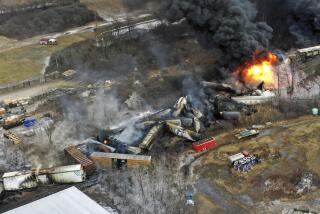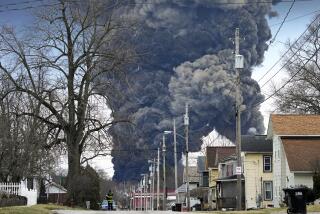River Disaster Blamed on Railroad Policy
- Share via
State Secretary of Resources Douglas Wheeler said Thursday that Southern Pacific could pay millions of dollars to cover losses from a pesticide spill in the Sacramento River, and in another development, a veteran railroad engineer accused the company of trying to save money by using insufficient power on the derailed train.
The Southern Pacific engineer, who has worked the rails of Siskiyou County for more than 15 years and asked not to be named, said the use of a “helper” engine probably would have prevented the catastrophic derailment, which fouled a 45-mile stretch of river and killed at least 100,000 fish.
The engineer said the use of helper locomotives has been discouraged for several years on all but the heaviest trains because it requires two extra crew members and consumes additional fuel. A Southern Pacific spokesman conceded that the absence of a helper locomotive was one potential cause of the accident but said saving money had nothing to do with the company’s operational decisions.
In a surprising development four days after the derailment released deadly chemicals into the Sacramento River above Dunsmuir, railroad officials confirmed that the ill-fated train contained a labeled car full of carbolic acid, a corrosive substance that is listed as hazardous by the federal government and might have caused far worse consequences for humans if it had spilled.
Southern Pacific spokesman Robert Taggart said three other empty cars also were marked with hazard placards because they contained residues from a previous load of chlorine, another dangerous chemical routinely routed through the steep river canyon where the accident occurred.
Meanwhile, the plume of toxic weed killer slowed to a virtual standstill in Shasta Lake but remained highly toxic to fish and other aquatic life. The slick, which once had a tail 11 miles long, became more compact and sank.
Boaters and fishermen were banned from the northernmost finger of the reservoir, a prime recreational destination and major source of agricultural and drinking water for California. But state officials confidently repeated their prediction that the pesticide will be diluted to safe levels by the time it reaches Shasta Dam.
Nonetheless, some residents continued to complain of persistent headaches and many were confused and alarmed by conflicting reports and rumors about the spilled chemical--a commonly used soil fumigant called metam-sodium--and its toxicity.
Air sampling results showed detectable toxic fumes along some parts of the river and officials continued to call for residents to voluntarily evacuate.
The state Department of Health Services and the California Environmental Protection Agency sent a team of specialists to the scene to begin tracking people who reported nausea, dizziness and other reactions to the pesticide.
Dr. Richard Jackson, a risk assessment specialist with Cal/EPA, said tests of metam-sodium with laboratory animals have not found long-term harm.
Health officials did warn anyone exposed to metam-sodium to avoid alcoholic beverages because they could cause a severe reaction, including vomiting, nausea and headaches. Dr. Robert Howd, a state toxicologist, said metam-sodium is similar to the chemical used in Antabuse, an anti-alcohol drug designed to make people ill if they drink. It is not certain that metam-sodium would cause the reaction but the state issued the warning just in case.
“If I thought I’d been exposed, I’d be real careful about my alcohol consumption,” Howd said.
Unable to do much about the chemical in the lake, government and railroad officials focused on “hot spots” of pesticide remaining in stagnant backwaters of the river, said Bill Gengler, a spokesman for the state Department of Fish and Game. He said officials plan to pump the residue into trucks and haul it to a dump.
Test results released Thursday show that the level of the chemical has decreased to an amount that is not lethal to fish in the upper stretch of the river.
State officials will hold their first meeting with Southern Pacific today to discuss the clean-up and compensation for all damages.
“We are going to attempt to hold them liable for losses suffered by the tourist industry,” said Wheeler, adding “We’re talking millions (of dollars).”
The state resources secretary said a record of accidents along the rail line could increase Southern Pacific’s liability.
“It’s an antiquated trestle. I think they are operating in ways that are apparently unsafe--long trains, and inadequate locomotion on either end (of the train). They’ve had one accident after another at that site,” Wheeler said later during a reception at Los Angeles City Hall.
Assemblyman Richard Katz (D-Sylmar), chairman of the Assembly Transportation Committee, said that because Southern Pacific is in a precarious financial situation, the state is considering filing liens to protect its recovery of money.
Katz also had harsh words for the U.S. Department of Transportation, which did not list metam-sodium as a hazardous material.
“The fact that the feds don’t consider it hazardous for that (rail transport) is outrageous,” Katz said. “If it had been properly categorized, it would have been in a double-hulled tanker, it would have been placarded and we wouldn’t have had this ecological disaster.”
Officially, the cause of the accident remained undetermined. But veteran railroad workers said there was little question why seven cars of the train jumped the tracks after crossing a trestle shortly before 10 p.m. Sunday.
They blamed the absence of a helper locomotive, the use of two lower-powered, four-axle engines instead of six-axle engines, and the excessive use of lubrication on the rails along the winding stretch of track.
The engineer said that since Southern Pacific was purchased in 1988 by Rio Grande Industries, the railroad has required a helper, or pusher engine, only on trains that weigh 4,500 tons or more; the train that derailed weighed 4,290 tons. Previously, the weight for trains requiring helpers was 3,900 tons.
Without adequate power near the back, cars can be pulled off the track when slack develops in the lengthy trains as they twist and turn through the tricky stretch, experts said.
Aggravating this phenomenon is the increased use of track lubricant, the veteran engineer said. Within the past year, he said, the railroad’s new owner directed that more grease be applied to the track in the Dunsmuir vicinity. This decreases friction as trains round curves, thereby reducing wear and tear on the track.
“Ever since they cranked up the lubricators, you can feel the wheels slip on the way up and slide a bit on the way down,” said the engineer. When the grease wears off and the wheels grab again on the ascent, it can cause a sudden tug that can derail cars in the rear, he said.
Finally, the engineer lamented the use of four-axle engines, which he said are less powerful and “are notorious for slipping.”
“They’re trying to save money . . . and you can’t blame them. My concern is personal safety,” the engineer said.
Taggart, the railroad’s spokesman, conceded that four-axle engines are “less powerful than six-axle engines, and if we had a rail yard full of six-axle engines we’d rather use them.”
As for the lubricant, he said it would only be a factor if the grease-releasing mechanisms on the track were out of adjustment.
“This company does not control costs in ways that would compromise safety,” he said.
Times staff writer Larry Stammer contributed to this story.
More to Read
Sign up for Essential California
The most important California stories and recommendations in your inbox every morning.
You may occasionally receive promotional content from the Los Angeles Times.










